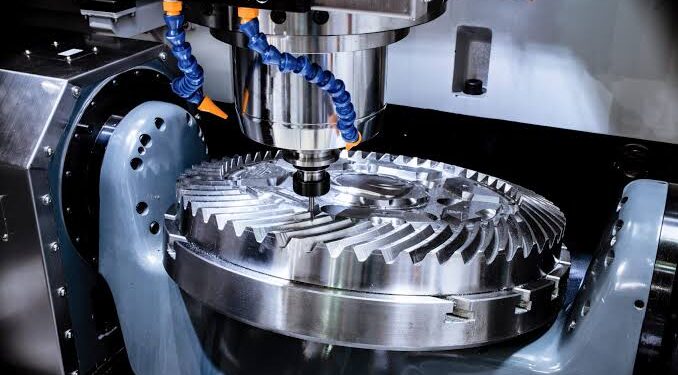CNC metal cutting is a precision-driven process where efficiency relies on proper parameter settings. Whether you’re a seasoned machinist or new to CNC operations, optimizing cutting parameters can drastically improve productivity, tool lifespan, and material quality.
Yet many struggle with inefficiencies such as excessive tool wear, poor surface finish, or slow production speeds. The good news is that you can overcome these challenges by fine-tuning key parameters and achieving optimal results.
This article will discuss the crucial factors influencing CNC metal cutting performance and the advanced strategies for refining them for maximum efficiency.
Optimizing CNC Metal Cutting Parameters: A Step-by-Step Guide
Optimizing CNC metal cutting parameters requires a strategic approach to enhance efficiency, precision, and tool longevity. Without the correct settings, operations can suffer from poor surface finishes, excessive tool wear, and material wastage, leading to increased costs and lower productivity.
The key to optimization lies in understanding the interplay between cutting parameters such as spindle speed, feed rate, depth of cut, and coolant application. Each factor influences the cutting process differently, and the ideal settings vary based on the material, tool type, and machine capability.
The step-by-step guide below will walk you through the essential adjustments to maximize performance. By fine-tuning these parameters, you can reduce cycle times, improve part quality, and extend tool life while maintaining process stability. The process involves:
- Understanding Material Properties: Knowing how different metals respond to cutting forces helps select optimal speeds and feeds.
- Setting the Right Cutting Speeds: Spindle speed and feed rate should be adjusted to balance productivity with tool wear.
- Optimizing Depth of Cut: Determining how deep each pass should be based on material hardness and machine capabilities.
- Utilizing Advanced Machining Strategies: Techniques like high-speed machining, trochoidal milling, and adaptive control can enhance performance.
- Monitoring and Adjusting in Real Time: Continuous tracking of tool wear and cutting conditions ensures optimal results throughout the machining process.
However, these parameters are not one-size-fits-all. They must be tailored to the machined material, the cutting tool, and the desired finish quality. In the section below, we will break down the key cutting parameters, explaining how each one impacts performance and how to find the right balance for maximum efficiency.
Key Parameters Affecting Cutting Performance
Image Showing Various CNC Machining Tools and Feeds
You must balance multiple parameters that impact speed, accuracy, and tool longevity to achieve efficient CNC metal cutting. Adjusting these correctly ensures minimal material waste, reduced machine strain, and high-quality finishes.
If any of these factors discussed below are not correctly adjusted, it can lead to tool wear, poor surface finishes, excessive heat generation, or even material damage.
1. Balancing Spindle Speed and Feed Rate
Spindle speed refers to the rotational speed of your cutting tool or workpiece in revolutions per minute (RPM). It is a critical parameter for determining the cutting speed and ensuring perfect material removal. On the other hand, the feed rate is the distance it takes your cutting tool to advance into the workpiece with each revolution of the spindle. The feed rate is typically measured in inches per minute (IPM) or millimeters per minute (MM/min).
Spindle speed and feed rate directly influence machining efficiency. The right balance prevents overheating, excessive tool wear, and poor surface finishes. Consider the material type, tool diameter, and desired surface finish to find the optimal balance. Many machinists use cutting speed formulas or rely on manufacturer recommendations to determine these values.
- Spindle Speed: Higher RPMs work well for softer metals but can cause excessive heat and tool degradation with harder materials. Lower speeds offer better control and longevity for robust metals like titanium.
- Feed Rate: Setting too high increases cutting forces, risking tool breakage. A low feed rate, however, reduces productivity and may cause work hardening in certain metals.
2. Optimal Cutting Depth for Different Metals
Cutting depth refers to the thickness of the material that the cutting tool removes in one pass. It is measured in millimeters or inches and affects tool engagement, material removal rate, heat generation, and the efficiency and quality of your machining process.
The depth of cut is not standardized but ranges from 0.5 to 2 millimeters for most materials. The exact value depends on the machined material and the abilities of your cutting tool and CNC machine. Different materials require specific depths to maximize efficiency:
- Aluminum and soft Metals Can tolerate deeper cuts due to their lower resistance, around 1-2 mm.
- Steel & Hard Alloys: Require shallower passes to avoid excessive tool strain; around 0.5-1 mm.
- Titanium & Heat-Resistant Alloys: Need incremental cutting depths to minimize heat buildup.
Image Showing the Relationship between Federate, Spindle speed, and Depth of Cut
3. Choosing the Right Tool Geometry and Coatings
The geometry and coating of your cutting tool significantly impact performance. Proper selection improves chip evacuation, heat dissipation, and overall efficiency.
- Flute Count: More flutes provide a smoother finish but may clog with certain materials. Fewer flutes improve chip evacuation for softer metals.
- Tool Coatings:
- TiN (Titanium Nitride): Great for general applications, increasing tool life.
- TiAlN (Titanium Aluminum Nitride): It withstands high temperatures and is ideal for hard metals.
- Diamond Coating: Best for non-ferrous metals like aluminum.
4. Controlling Chip Load and Chip Evacuation
Chip load refers to the material removed by each tool’s cutting edge during a single pass. It is a vital parameter during your CNC machining process as it impacts the quality of your cut, tool life, and overall machining performance.
Efficient chip removal prevents tool clogging, overheating, and rough surface finishes. Proper chip load management ensures smoother operations:
- Chip Load Optimization: Adjusting feed rate and spindle speed helps maintain a consistent chip thickness, preventing excess heat.
- Coolant & Air Blast: Using the proper lubrication method enhances chip evacuation and controls temperatures.
Advanced Optimization Strategies
Once the fundamental cutting parameters are set, further optimization is needed to push your CNC machine metal cutting efficiency to the next level. Advanced strategies help refine the process, ensuring higher precision, reduced tool wear, and improved surface quality while maintaining cost-effectiveness.
These strategies involve fine-tuning parameters based on material characteristics, implementing high-efficiency machining techniques, and leveraging modern technologies such as real-time monitoring. These methods can enhance productivity, minimize waste, and extend tool life, even in high-volume or complex machining operations. Below are some strategies you can apply:
1. Material-Specific Parameter Adjustments
Every metal behaves differently under machining stress. Factors like hardness, thermal conductivity, and chip formation characteristics affect how a material responds to machining. Using material-specific cutting data rather than generic settings maximizes efficiency and tool lifespan. Tailoring parameters to the properties of your materials ensures better results. For example,
- Soft Metals (e.g., Aluminum, Copper): Due to their lower hardness, soft metals require high spindle speeds, moderate feed rates, and minimal coolant. However, their tendency to produce long, stringy chips requires precise chip-breaking strategies and the correct cutting tool geometry.
- Hard Metals (e.g., Titanium, Inconel, Hardened Steel) Benefit from lower speeds, higher feed rates, continuous lubrication, and carbide or coated tools that withstand wear. Heat buildup can be a major issue, so proper coolant application and heat-resistant coatings are essential.
- Brittle Materials (e.g., Cast Iron, Ceramics): These materials break rather than deform, requiring lower feed rates and minimal cutting forces to prevent cracking. Dry machining or minimal coolant use is often preferred to prevent thermal shock.
2. Reducing Surface Roughness and Burrs
Poor surface finishes and burr formation are common in machining leading to excessive roughness, requiring additional finishing operations. Addressing these enhances product quality and reduces secondary finishing steps.
- Reducing Vibrations: Machine and tool vibrations contribute to surface irregularities. Using dampened tool holders, rigid setups, and dynamic balancing techniques can significantly reduce chatter and improve finish quality.
- Fine-Tuning Feed Rate & Spindle Speed: A high feed rate can cause tool marks on the surface, while low spindle speeds may lead to built-up edge formation. Finding the right balance helps achieve a clean, smooth finish. Incremental passes with reduced feed rates improve finishes.
- Using Sharp Cutting Tools and Coating: Dull tools cause tearing and increasing burr formation. Coatings like TiAlN or DLC can minimize friction and heat buildup, resulting in cleaner cuts. Also, regular maintenance or replacing worn tools is essential.
3. Implementing High-Efficiency Machining Techniques
Modern machining strategies can significantly enhance productivity while maintaining precision.
- Trochoidal Milling: Uses circular toolpaths to reduce heat and extend tool life, especially in hard metals.
- Peck Drilling: Prevents tool overheating in deep hole drilling by retracting periodically.
- High-Speed Machining (HSM): This technique involves using higher spindle speeds and lighter depths of cut, allowing for faster material removal while reducing heat buildup and tool wear.
4. Monitoring and Adjusting in Real-Time
Using real-time data and artificial intelligence (AI) in CNC machining revolutionizes optimization strategies. Based on performance feedback, advanced monitoring systems help detect real-time tool wear, cutting forces, and temperature fluctuations.
- Sensors & Software: Integrated monitoring systems detect anomalies like excess vibrations or tool wear.
- Adaptive Control: Adjusts feed rates automatically based on cutting conditions, improving efficiency and reducing tool damage.
Conclusion
Optimizing CNC metal cutting parameters requires carefully balancing speed, feed, depth, tool selection, and machining strategies. You can achieve greater efficiency, extended tool life, and superior surface finishes by fine-tuning these elements and incorporating advanced techniques.
Successful machining isn’t just about running the machine; it’s about understanding the intricate relationships between parameters and adjusting them for the best possible performance.





